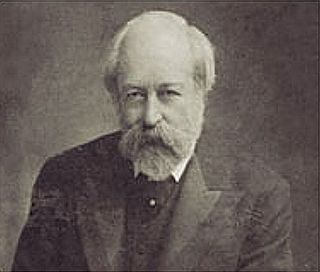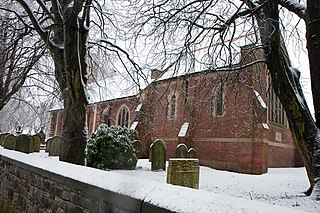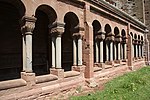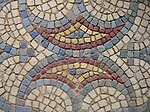
George Frederick Bodley was an English Gothic Revival architect. He was a pupil of Sir George Gilbert Scott, and worked in partnership with Thomas Garner for much of his career. He was one of the founders of Watts & Co.

Hoarwithy is a small village in the civil parish of Hentland, and on the River Wye in Herefordshire, England.

Hentland is a hamlet and civil parish about 5 miles (8 km) north-west of Ross-on-Wye in Herefordshire, England.

The Church of St Mary and St David is a Church of England parish church at Kilpeck in the English county of Herefordshire, about 5 miles from the border with Monmouthshire, Wales. Pevsner describes Kilpeck as "one of the most perfect Norman churches in England". Famous for its stone carvings, the church is a Grade I listed building.

St Mary's Church is in the village of Whitegate, Cheshire, England. It is an active Anglican parish church in the diocese of Chester, the archdeaconry of Chester and the deanery of Middlewich. Its benefice is combined with that of St Peter, Little Budworth. The church is recorded in the National Heritage List for England as a designated Grade II listed building. The authors of the Buildings of England series state that the "church is placed so happily against trees on a hillside that it makes the perfect, comforting picture of the Victorian village church".

St John the Baptist's Church is in the village of Guilden Sutton, near Chester, Cheshire, England. It is recorded in the National Heritage List for England as a designated Grade II listed building. It is an active Anglican parish church. The church is in the diocese of Chester, the archdeaconry of Chester and the deanery of Chester. Its benefice is combined with that of St Peter, Plemstall.

St John the Evangelist's Church is in the village of Alvanley, Cheshire, England. It is an active Anglican parish church in the diocese of Chester, the archdeaconry of Chester and the deanery of Frodsham. Its benefice is united with that of St John the Evangelist, Manley. The church is recorded in the National Heritage List for England as a designated Grade II listed building. It is described by the authors of the Buildings of England series as "a building of some character".

St Paul's Church overlooks the River Dee in Boughton, Chester, Cheshire, England. The church is recorded in the National Heritage List for England as a designated Grade II* listed building, and, before its closure, was an Anglican parish church in the diocese of Chester, the archdeaconry of Chester and the deanery of that diocese. In the series Buildings of England, the architectural historian Nikolaus Pevsner stated that he regarded it as "the boldest of Douglas' church designs".

St John the Evangelist's Church is in the small village of Byley, Cheshire, England. It is recorded in the National Heritage List for England as a designated Grade II listed building. It is an active Anglican parish church in the diocese of Chester, the archdeaconry of Chester and the deanery of Middlewich. Its benefice is combined with that of St Michael and All Angels, Middlewich. The architectural historian Nikolaus Pevsner regarded it as being "really very beautiful" with a "minimum of motifs, but a maximum of materials".

St Michael and All Angels Church stands to the west of the village of Great Altcar, West Lancashire, England. The church is timber-framed and is recorded in the National Heritage List for England as a designated Grade II* listed building. It is an active Anglican parish church in the diocese of Liverpool, the archdeaconry of Liverpool and the deanery of Sefton. Its benefice is combined with that of Holy Trinity, Formby. In the Buildings of England series it is described as "an utterly charming church".
John West Hugall was an English Gothic Revival architect from Yorkshire.

St Paul's Church is in the village of Farington Moss, Lancashire, England. It is an active Anglican parish church in the deanery of Leyland, the archdeaconry of Blackburn and the diocese of Blackburn. Its benefice is united with that of St James, Lostock Hall. The church is recorded in the National Heritage List for England as a designated Grade II listed building. It was a Commissioners' church, having received a grant towards its construction from the Church Building Commission.

John Pollard Seddon FRIBA was a British architect, working largely on churches.

St Thomas' Church is an Anglican church in St Anne's-on-the-Sea, a town on the Fylde coastal plain in Lancashire, England. It is an active parish church in the Diocese of Blackburn and the archdeaconry of Lancaster. Designed by Austin and Paley, it is recorded in the National Heritage List for England as a designated Grade II listed building.

Romanesque Revival, Norman Revival or Neo-Norman styles of building in the United Kingdom were inspired by the Romanesque architecture of the 11th and 12th centuries AD.

The Church of All Saints is a Church of England parish church at Brockhampton in the English county of Herefordshire. The church was commissioned by Alice Foster as a memorial to her parents, Eben and Julia Jordan. The architect was William Lethaby and construction took place between 1901 and 1902. It is a Grade I listed building and is considered among the best examples of the works of the Arts and Crafts movement.

St Giles' Church, Goodrich, Herefordshire, England is an Anglican parish church in the Diocese of Hereford. The church dates from the 13th century, although almost all of the current building is of the 14th century, or from the 19th century restoration. It is an active parish church and a Grade II* listed building.

The Church of St James is a Church of England parish church at Kinnersley in the English county of Herefordshire. It is a Grade I listed building.

St Weonard's Church, St Weonard is a Grade I listed parish church in St Weonards, Herefordshire, England.

St Dubricius’ Church, Hentland is a Grade II* listed parish church in Hentland, Herefordshire,England.
























